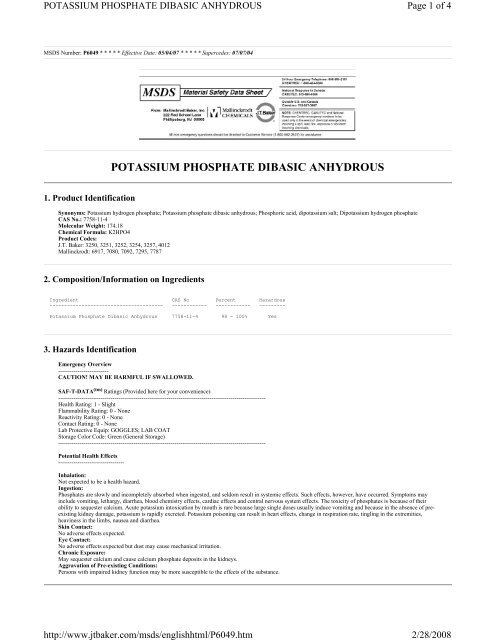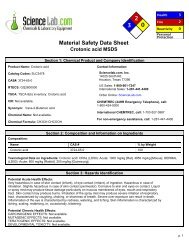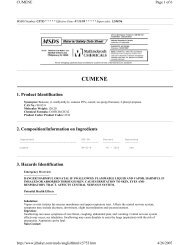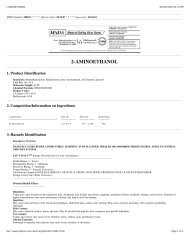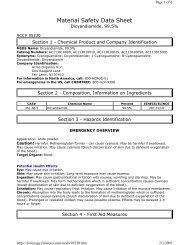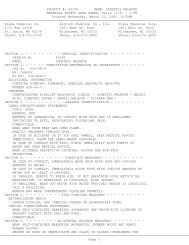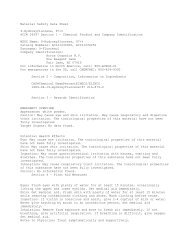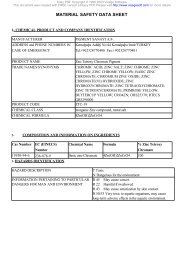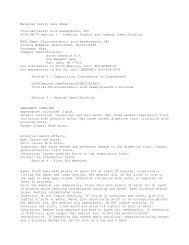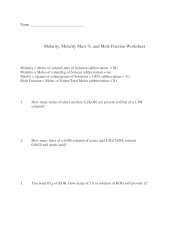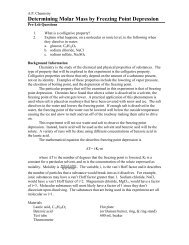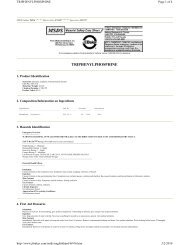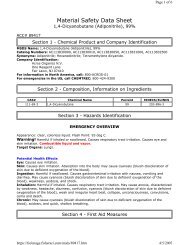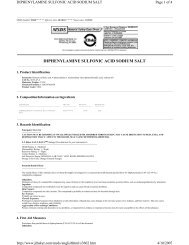MSDS PDF/D/Dipotassium hydrogen phosphate.pdf
MSDS PDF/D/Dipotassium hydrogen phosphate.pdf
MSDS PDF/D/Dipotassium hydrogen phosphate.pdf
You also want an ePaper? Increase the reach of your titles
YUMPU automatically turns print PDFs into web optimized ePapers that Google loves.
POTASSIUM PHOSPHATE DIBASIC ANHYDROUS<br />
http://www.jtbaker.com/msds/englishhtml/P6049.htm<br />
Page 1 of 4<br />
2/28/2008<br />
<strong>MSDS</strong> Number: P6049 * * * * * Effective Date: 05/04/07 * * * * * Supercedes: 07/07/04<br />
POTASSIUM PHOSPHATE DIBASIC ANHYDROUS<br />
1. Product Identification<br />
Synonyms: Potassium <strong>hydrogen</strong> <strong>phosphate</strong>; Potassium <strong>phosphate</strong> dibasic anhydrous; Phosphoric acid, dipotassium salt; <strong>Dipotassium</strong> <strong>hydrogen</strong> <strong>phosphate</strong><br />
CAS No.: 7758-11-4<br />
Molecular Weight: 174.18<br />
Chemical Formula: K2HPO4<br />
Product Codes:<br />
J.T. Baker: 3250, 3251, 3252, 3254, 3257, 4012<br />
Mallinckrodt: 6917, 7080, 7092, 7295, 7787<br />
2. Composition/Information on Ingredients<br />
Ingredient CAS No Percent Hazardous<br />
--------------------------------------- ------------ ------------ ---------<br />
Potassium Phosphate Dibasic Anhydrous 7758-11-4 98 - 100% Yes<br />
3. Hazards Identification<br />
Emergency Overview<br />
--------------------------<br />
CAUTION! MAY BE HARMFUL IF SWALLOWED.<br />
SAF-T-DATA (tm) Ratings (Provided here for your convenience)<br />
-----------------------------------------------------------------------------------------------------------<br />
Health Rating: 1 - Slight<br />
Flammability Rating: 0 - None<br />
Reactivity Rating: 0 - None<br />
Contact Rating: 0 - None<br />
Lab Protective Equip: GOGGLES; LAB COAT<br />
Storage Color Code: Green (General Storage)<br />
-----------------------------------------------------------------------------------------------------------<br />
Potential Health Effects<br />
----------------------------------<br />
Inhalation:<br />
Not expected to be a health hazard.<br />
Ingestion:<br />
Phosphates are slowly and incompletely absorbed when ingested, and seldom result in systemic effects. Such effects, however, have occurred. Symptoms may<br />
include vomiting, lethargy, diarrhea, blood chemistry effects, cardiac effects and central nervous system effects. The toxicity of <strong>phosphate</strong>s is because of their<br />
ability to sequester calcium. Acute potassium intoxication by mouth is rare because large single doses usually induce vomiting and because in the absence of preexisting<br />
kidney damage, potassium is rapidly excreted. Potassium poisoning can result in heart effects, change in respiration rate, tingling in the extremities,<br />
heaviness in the limbs, nausea and diarrhea.<br />
Skin Contact:<br />
No adverse effects expected.<br />
Eye Contact:<br />
No adverse effects expected but dust may cause mechanical irritation.<br />
Chronic Exposure:<br />
May sequester calcium and cause calcium <strong>phosphate</strong> deposits in the kidneys.<br />
Aggravation of Pre-existing Conditions:<br />
Persons with impaired kidney function may be more susceptible to the effects of the substance.
POTASSIUM PHOSPHATE DIBASIC ANHYDROUS<br />
http://www.jtbaker.com/msds/englishhtml/P6049.htm<br />
Page 2 of 4<br />
2/28/2008<br />
4. First Aid Measures<br />
Inhalation:<br />
Remove to fresh air. Get medical attention for any breathing difficulty.<br />
Ingestion:<br />
If swallowed, give several glasses of water to drink to dilute. If large amounts were swallowed or symptoms occur, get medical advice. Never give anything by<br />
mouth to an unconscious person.<br />
Skin Contact:<br />
Wash exposed area with soap and water. Get medical advice if irritation develops.<br />
Eye Contact:<br />
Wash thoroughly with running water. Get medical advice if irritation develops.<br />
5. Fire Fighting Measures<br />
Fire:<br />
Not considered to be a fire hazard.<br />
Explosion:<br />
Not considered to be an explosion hazard.<br />
Fire Extinguishing Media:<br />
Use any means suitable for extinguishing surrounding fire.<br />
Special Information:<br />
In the event of a fire, wear full protective clothing and NIOSH-approved self-contained breathing apparatus with full facepiece operated in the pressure demand<br />
or other positive pressure mode.<br />
6. Accidental Release Measures<br />
Ventilate area of leak or spill. Wear appropriate personal protective equipment as specified in Section 8. Spills: Sweep up and containerize for reclamation or<br />
disposal. Vacuuming or wet sweeping may be used to avoid dust dispersal.<br />
7. Handling and Storage<br />
Keep in a tightly closed container, stored in a cool, dry, ventilated area. Protect against physical damage. Containers of this material may be hazardous when<br />
empty since they retain product residues (dust, solids); observe all warnings and precautions listed for the product.<br />
8. Exposure Controls/Personal Protection<br />
Airborne Exposure Limits:<br />
None established.<br />
Ventilation System:<br />
A system of local and/or general exhaust is recommended to keep employee exposures as low as possible. Local exhaust ventilation is generally preferred because<br />
it can control the emissions of the contaminant at its source, preventing dispersion of it into the general work area. Please refer to the ACGIH document,<br />
Industrial Ventilation, A Manual of Recommended Practices, most recent edition, for details.<br />
Personal Respirators (NIOSH Approved):<br />
For conditions of use where exposure to dust or mist is apparent and engineering controls are not feasible, a particulate respirator (NIOSH type N95 or better<br />
filters) may be worn. If oil particles (e.g. lubricants, cutting fluids, glycerine, etc.) are present, use a NIOSH type R or P filter. For emergencies or instances where<br />
the exposure levels are not known, use a full-face positive-pressure, air-supplied respirator. WARNING: Air-purifying respirators do not protect workers in<br />
oxygen-deficient atmospheres.<br />
Skin Protection:<br />
Wear protective gloves and clean body-covering clothing.<br />
Eye Protection:<br />
Safety glasses. Maintain eye wash fountain and quick-drench facilities in work area.<br />
9. Physical and Chemical Properties<br />
Appearance:<br />
Deliquescent white crystals or powder.<br />
Odor:<br />
Odorless.<br />
Solubility:<br />
150g/100g cold water<br />
Specific Gravity:<br />
No information found.<br />
pH:<br />
No information found.<br />
% Volatiles by volume @ 21C (70F):<br />
0<br />
Boiling Point:<br />
Not applicable.<br />
Melting Point:<br />
> 465C (> 869F)<br />
Vapor Density (Air=1):
POTASSIUM PHOSPHATE DIBASIC ANHYDROUS<br />
http://www.jtbaker.com/msds/englishhtml/P6049.htm<br />
Page 3 of 4<br />
2/28/2008<br />
No information found.<br />
Vapor Pressure (mm Hg):<br />
No information found.<br />
Evaporation Rate (BuAc=1):<br />
No information found.<br />
10. Stability and Reactivity<br />
Stability:<br />
Stable under ordinary conditions of use and storage. Slightly hygroscopic.<br />
Hazardous Decomposition Products:<br />
Phosphorus oxides may form when heated to decomposition.<br />
Hazardous Polymerization:<br />
Will not occur.<br />
Incompatibilities:<br />
No incompatibility data found.<br />
Conditions to Avoid:<br />
No information found.<br />
11. Toxicological Information<br />
No LD50/LC50 information found relating to normal routes of occupational exposure.<br />
--------\Cancer Lists\------------------------------------------------------<br />
---NTP Carcinogen---<br />
Ingredient Known Anticipated IARC Category<br />
------------------------------------ ----- ----------- -------------<br />
Potassium Phosphate Dibasic No No None<br />
Anhydrous (7758-11-4)<br />
12. Ecological Information<br />
Environmental Fate:<br />
No information found.<br />
Environmental Toxicity:<br />
No information found.<br />
13. Disposal Considerations<br />
Whatever cannot be saved for recovery or recycling should be managed in an appropriate and approved waste disposal facility. Processing, use or contamination<br />
of this product may change the waste management options. State and local disposal regulations may differ from federal disposal regulations. Dispose of container<br />
and unused contents in accordance with federal, state and local requirements.<br />
14. Transport Information<br />
Not regulated.<br />
15. Regulatory Information<br />
--------\Chemical Inventory Status - Part 1\---------------------------------<br />
Ingredient TSCA EC Japan Australia<br />
----------------------------------------------- ---- --- ----- ---------<br />
Potassium Phosphate Dibasic Anhydrous Yes Yes Yes Yes<br />
(7758-11-4)<br />
--------\Chemical Inventory Status - Part 2\---------------------------------<br />
--Canada--<br />
Ingredient Korea DSL NDSL Phil.<br />
----------------------------------------------- ----- --- ---- -----<br />
Potassium Phosphate Dibasic Anhydrous Yes Yes No Yes<br />
(7758-11-4)<br />
--------\Federal, State & International Regulations - Part 1\----------------<br />
-SARA 302- ------SARA 313------<br />
Ingredient RQ TPQ List Chemical Catg.<br />
----------------------------------------- --- ----- ---- --------------<br />
Potassium Phosphate Dibasic Anhydrous No No No No<br />
(7758-11-4)<br />
--------\Federal, State & International Regulations - Part 2\----------------<br />
-RCRA- -TSCA-<br />
Ingredient CERCLA 261.33 8(d)<br />
----------------------------------------- ------ ------ ------
POTASSIUM PHOSPHATE DIBASIC ANHYDROUS<br />
http://www.jtbaker.com/msds/englishhtml/P6049.htm<br />
Page 4 of 4<br />
2/28/2008<br />
Potassium Phosphate Dibasic Anhydrous No No No<br />
(7758-11-4)<br />
Chemical Weapons Convention: No TSCA 12(b): No CDTA: No<br />
SARA 311/312: Acute: Yes Chronic: No Fire: No Pressure: No<br />
Reactivity: No<br />
(Pure / Solid)<br />
Australian Hazchem Code: None allocated.<br />
Poison Schedule: None allocated.<br />
WHMIS:<br />
This <strong>MSDS</strong> has been prepared according to the hazard criteria of the Controlled Products Regulations (CPR) and the <strong>MSDS</strong> contains all of the information<br />
required by the CPR.<br />
16. Other Information<br />
NFPA Ratings: Health: 1 Flammability: 0 Reactivity: 0<br />
Label Hazard Warning:<br />
CAUTION! MAY BE HARMFUL IF SWALLOWED.<br />
Label Precautions:<br />
Wash thoroughly after handling.<br />
Label First Aid:<br />
If swallowed, give several glasses of water to drink to dilute. If large amounts were swallowed or symptoms occur, get medical advice. Never give anything by<br />
mouth to an unconscious person.<br />
Product Use:<br />
Laboratory Reagent.<br />
Revision Information:<br />
<strong>MSDS</strong> Section(s) changed since last revision of document include: 3.<br />
Disclaimer:<br />
************************************************************************************************<br />
Mallinckrodt Baker, Inc. provides the information contained herein in good faith but makes no representation as to its comprehensiveness or accuracy.<br />
This document is intended only as a guide to the appropriate precautionary handling of the material by a properly trained person using this product.<br />
Individuals receiving the information must exercise their independent judgment in determining its appropriateness for a particular purpose.<br />
MALLINCKRODT BAKER, INC. MAKES NO REPRESENTATIONS OR WARRANTIES, EITHER EXPRESS OR IMPLIED, INCLUDING<br />
WITHOUT LIMITATION ANY WARRANTIES OF MERCHANTABILITY, FITNESS FOR A PARTICULAR PURPOSE WITH RESPECT TO<br />
THE INFORMATION SET FORTH HEREIN OR THE PRODUCT TO WHICH THE INFORMATION REFERS. ACCORDINGLY,<br />
MALLINCKRODT BAKER, INC. WILL NOT BE RESPONSIBLE FOR DAMAGES RESULTING FROM USE OF OR RELIANCE UPON THIS<br />
INFORMATION.<br />
************************************************************************************************<br />
Prepared by: Environmental Health & Safety<br />
Phone Number: (314) 654-1600 (U.S.A.)


